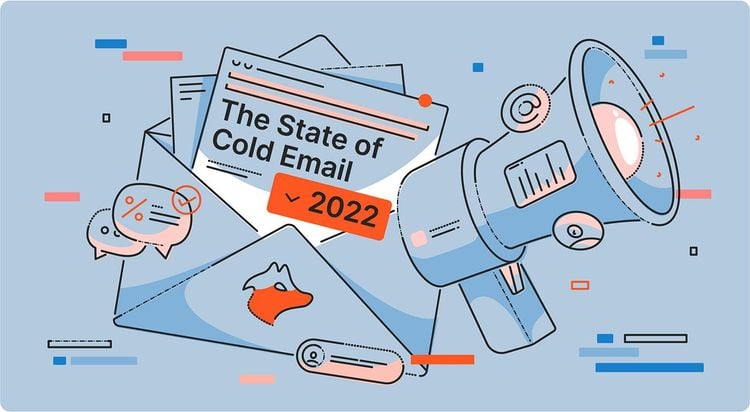The State of Cold Email 2022

Curious about how everyone else is doing cold email outreach? We were too.
That’s why we surveyed 440 Hunter users to find out what they’re using cold email outreach for, how they’re setting up their campaigns, and what kind of results they’re getting.
Here’s what we found out.
Cold email outreach has become more difficult over the past year
54.4% of survey respondents state that cold email outreach has become more difficult over the past year.
This makes sense — as cold outreach becomes a more popular method of driving new business, more and more companies are sending cold emails. This makes it harder for the average cold email to stand out in recipients’ inboxes.
Luckily, there are quite a few things you can do to generate better results with cold email outreach. You can:
- Understand your prospects better – Start by researching your prospects so that you can have a better understanding of their pain points and goals. Or even better, take the time to create an ideal customer profile.
- Write better cold emails – Writing cold emails is both an art and a science. Use these tips to create high-converting cold emails.
- Improve deliverability – Are you doing everything you can to maximize the deliverability of your cold emails? Use this guide to make sure your cold emails land in the inbox every time.
Cold emails are primarily used for lead generation, link building, and networking
When asked what they use cold email outreach for, the vast majority of respondents (79.1%) state that they use it for lead generation. Other popular use cases include networking (33.5%), link building (18.3%), and recruitment (9.6%).
Wondering what else you can use cold outreach for? Our users have used cold emails to get jobs at their dream companies, find new affiliate marketing opportunities, and more.
Most companies are using software to automate cold email campaigns
72.9% of survey respondents spend anywhere between 1 to 10 hours every month managing cold email campaigns. 27% state they’re spending even more time than that every month on managing their campaigns.
However, there’s a lot of opportunity for reducing the time spent on managing campaigns using software. Still, 44.9% of respondents state that they don’t use any type of software to automate campaigns.
Tools like Hunter Campaigns can help you automate cold emails and follow-ups, personalize emails at scale, and track your results with ease.
The average cold email has an open rate below 30%
53.1% of survey respondents get less than a third of their cold emails opened.
However, higher open rates for cold emails are indeed possible. 43.4% of respondents see open rates between 30% to 80%, while a small group (3.5%) see open rates higher than 80%.
This is proof that if you do things right, you can see very high open rates for your cold emails.
Here are a few things you can do to increase your open rate:
- Personalize the subject line – A lot of people will decide whether to open your email based on the subject line. A great way to grab their attention and entice them to open your email is to personalize the subject line. You can find examples of personalized cold email subject lines here.
- Create a sense of urgency – If you can make your email sound urgent, this can help with getting recipients to open your email as soon as they see it rather than leaving it for later.
- Send follow-up emails – Every time you send a follow-up email in the same thread you sent your original cold email in, your email will get bumped to the top of the recipient’s inbox. This will help to improve the visibility of your message and make it more likely that the recipient will open your email.
Personalization is still the best way to improve open and reply rates
74.5% of survey respondents see higher open rates when they use personalized subject lines for their cold emails. Still, 38.7% don’t use any type of personalization.
57.2% of respondents use between 1 to 5 personalization tags in their cold emails. 20.2% go a step further and take advantage of personalized images and videos.
Here are a few ways you can personalize your cold emails:
- Congratulate the prospect on a recent achievement – A great way to personalize a cold email is to congratulate the prospect on a recent achievement or compliment their work. This will show them that you’ve done your research and help to build rapport.
- Mention a mutual acquaintance – If you and the prospect have a mutual acquaintance, mentioning this can be a great icebreaker and a way to grab their attention. It’s even better if you can get the acquaintance to introduce you to the prospect.
- Talk about their pain points and goals – If you’ve done your research, you should know your recipient’s current pain points and goals. Mentioning these in your email is a surefire way to get the prospect’s attention.
Want to learn more? Read our guide to email personalization.
Follow-up emails have a significant effect on response rates
39.8% of survey respondents send between 2 to 3 follow-ups to their original cold email. Data shows that this is a really good idea, since it’s been proven that following up with a prospect multiple times can double your response rate.
Unfortunately, not everyone is taking advantage of this fact. 13.3% of survey respondents don’t send follow-up emails at all.
Out of those that do, however, the vast majority (75.8%) use the original email thread to send the follow-up. This seems to be the preferred way to send a follow-up email.
It makes sense — by sending the follow-up in the same thread as the original cold email, you make it easier for the recipient to review all the information you’ve provided to them up to that point.
Want to make your follow-up emails as effective as possible? Follow these tips:
- Recap your previous email – Don’t assume the recipient read your original cold email. Provide a quick recap of your original message within your follow-up email.
- Add value – Don’t make it seem like you’re following up just for the sake of following up. Add some value for the recipient with each follow-up you send (e.g., by providing them with new information or sharing a resource that might help them solve a pain point they have).
- End with a call-to-action – Your email should end with a clear call-to-action that lets the recipient know what they need to do next.
You can learn more about sending effective follow-up emails here.
The majority of cold emails are sent Monday through Friday
Only 19.9% of survey respondents stated that they send cold emails on weekends. The reasoning behind this is that most prospects won’t be checking their work email on weekends.
However, with so few cold emails going out on weekends, it might be worth it to experiment with weekend campaigns in certain cases. Whether this will make sense for you will depend on your target audience and offer.
Multi-channel campaigns are on the rise
64.2% of respondents combine two to three different channels when doing cold outreach. This is great news, since using multiple channels for outreach increases your chances of getting a response.
The second most used channel after email is LinkedIn, by far (57.7%), followed by phone (21.4%).
Top cold email tips from Hunter users
We also asked survey respondents to share their top tips for getting better results with cold email outreach. Here’s what they said:
Research your prospects
The most common tip we received from users concerns researching prospects. Having a good understanding of who you’re reaching out to is crucial for generating good results from cold outreach.
Try to figure out your prospects’ key pain points and challenges and find out what their day-to-day looks like. This will help you understand how to word your cold email to get their attention.
The first place you can start researching prospects is through their LinkedIn profile. This should give you a decent amount of information to work with.
If you’d like to learn more about the prospect, you can also check out their personal website (if they have one) or their company website.
Make it human
It’s important to make your cold email look like an actual human sent it, even if you decide to automate your cold email campaign completely.
So, how do you do this? Start by using conversational language — avoid sounding too formal.
If you’re using a cold email template, make sure not to copy it word-for-word. Instead, adapt it to your audience and offer.
Keep it short
Your cold email should accomplish one thing: let the prospect know who you are and how they might benefit from working with you. That’s it.
When done right, you can accomplish the above in four to five sentences. Try not to make your cold email any longer than that.
The shorter your email is, the greater the chance that the prospect will read it in its entirety. If they open your email and are greeted by a wall of text, there’s a good chance that they won’t even bother to read it.
Avoid spam trigger words
We’ve talked about spam filters on the blog before. One particular type of spam filters, known as content filters, are designed to go through the content of every email that lands in the inbox, looking for any words or phrases that might hint at the email being spam.
These words or phrases are known as spam trigger words. There are too many of these trigger words and phrases to list here, but here’s a great list you can reference.
When writing your cold email copy, try to avoid using these words. This will help to reduce the chances of your email being marked as spam.
For more tips on avoiding the spam folder, check out this guide.
Remember to proofread
Spelling and grammar might be the last things you would think of when looking to get better results from your cold emails. But, they’re more important than they seem at first glance.
If you’re sending a cold email to someone who’s never heard of you, that will be their first impression of you as a person.
Whatever you’re offering, you likely want to come off as a professional who knows what they’re doing. That’s going to be hard to do if your email is full of grammatical and spelling errors.
So, before you send your next cold email, make sure to proofread it thoroughly. You can also use a tool like Grammarly to make sure your email is error-free.
That’s it until next year
We hope you’ve found this report helpful. If you’d like to learn even more about creating great cold email campaigns, check out these guides:
- The Complete Guide to Getting Started with Cold Email
- 5 Lessons I Learned After Sending 12K Cold Emails Last Year
- How to Write a Cold Email That Converts (Without Being Pushy)




 Send cold emails with Hunter
Send cold emails with Hunter